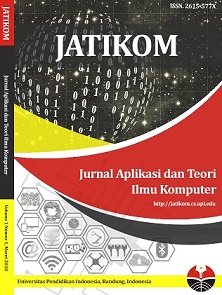Implementasi Neural Network untuk Mengenali Kepribadian Seseorang Menggunakan Model Big Five Personality Berdasarkan Rating Genre Video Game yang Diberikan oleh Responden
Abstract
yang perlu dikenali karena memiliki berbagai kegunaan,
diantaranya ialah untuk melakukan crowdsourcing, memilih
seseorang yang cocok menjadi pemimpin, dan meningkatkan
kemampuan metakognisi guru bahasa. Salah satu machine
learning yang dapat digunakan untuk mengenali kepribadian
seseorang ialah Automatic Personality Recognition (APR).
Pada APR, model kepribadian yang sering digunakan ialah
big five personality. Model big five personality telah diteliti
memiliki korelasi dengan preferensi genre video game yang
berbentuk data kuesioner berskala rating. Neural network
pernah digunakan sebagai algoritma APR dengan data rating
desain karakter video game. Neural network juga telah diteliti
memiliki kinerja yang lebih baik dari teknik statistik standar
untuk data kuesioner berskala rating. Penelitian skripsi ini
membahas tentang APR yang menggunakan data rating
genre video game sebagai fitur, big five personality sebagai
model kepribadian, dan neural network sebagai algoritma.
Data rating genre video game didapat dengan kuesioner
preferensi genre video game dan data big five personality
didapat dengan kuesioner Big Five Inventory Socio-Economic
Panel (BFI-S). Penelitian ini terdiri dari beberapa tahap,
yaitu: (1) Pembuatan Kuesioner; (2) Pengumpulan Data; (3)
Eksperimen; (4) Analisis Hasil. Hasil penelitian ini
menunjukkan bahwa: (1) Fitur rating genre video game
efektif untuk mengenali dimensi kepribadian
conscientiousness dengan RMSE sebesar 0.79459; (2) Neural
network mengeluarkan hasil yang lebih baik dari teknik
statistik standar; (3) Neural network bukanlah metode
terbaik dalam APR menggunakan model big five personality
berdasarkan rating genre video game.
Keywords
Full Text:
PDFReferences
A. Vinciarelli dan G. Mohammadi, “A Survey of Personality
Computing,” IEEE Trans. Affect. Comput., vol. 5, no. 3, hal. 273–
, 2014.
M. Z. Tunio et al., “Impact of Personality on Task Selection in
Crowdsourcing Software Development: A Sorting Approach,” IEEE
Access, vol. 5, hal. 18287–18294, 2017.
G. Huszczo dan M. L. Endres, “Gender differences in the
importance of personality traits in predicting leadership selfefficacy,” Int. J. Train. Dev., vol. 21, no. 4, hal. 304–317, 2017.
H. Öz, “The Importance of Personality Traits in Students’
Perceptions of Metacognitive Awareness,” Procedia - Soc. Behav.
Sci., vol. 232, hal. 655–667, 2016.
L. Teijeiro-Mosquera, J. I. Biel, J. L. Alba-Castro, dan D. GaticaPerez, “What your face vlogs about: Expressions of emotion and
big-five traits impressions in youtube,” IEEE Trans. Affect.
Comput., vol. 6, no. 2, hal. 193–205, 2015.
L. Batrinca, N. Mana, B. Lepri, N. Sebe, dan F. Pianesi,
“Multimodal Personality Recognition in Collaborative GoalOriented Tasks,” IEEE Trans. Multimed., vol. 18, no. 4, hal. 659–
, 2016.
C. Segalin, A. Perina, M. Cristani, dan A. Vinciarelli, “The Pictures
We Like Are Our Image: Continuous Mapping of Favorite Pictures
into Self-Assessed and Attributed Personality Traits,” IEEE Trans.
Affect. Comput., vol. 8, no. 2, hal. 268–285, 2017.
F. Rangel, F. González, F. Restrepo, M. Montes, dan P. Rosso,
“PAN@FIRE: Overview of the PR-SOCO Track on Personality
Recognition in SOurce COde,” Lect. Notes Comput. Sci., vol.
, no. 1, hal. 1–19, 2018.
F. Johnsson, “Personality measures under focus: The NEO-PI-R and
the MBTI,” Griffith Univ. Undergrad. Student Psychol. J., vol. 1,
B. Braun, J. M. Stopfer, K. W. Müller, M. E. Beutel, dan B. Egloff,
“Personality and video gaming: Comparing regular gamers, nongamers, and gaming addicts and differentiating between game
genres,” Comput. Human Behav., vol. 55, hal. 406–412, 2016.
N. Peever, D. Johnson, dan J. Gardner, “Personality & video game
genre preferences,” in Proceedings of The 8th Australasian
Conference on Interactive Entertainment Playing the System - IE
’12, 2012, hal. 1–3.
M. J. P. Wolf, “Genre and the video game,” Mediu. video game, hal.
–134, 2001.
W. Y. K. Chiang, D. Zhang, dan L. Zhou, “Predicting and
explaining patronage behavior toward web and traditional stores
using neural networks: A comparative analysis with logistic
regression,” Decis. Support Syst., vol. 41, no. 2, hal. 514–531, 2006.
R. J. Thieme, M. Song, dan R. J. Calantone, “Artificial neural
network decision support systems for new product development
project selection,” J. Mark. Res., vol. 37, no. 4, hal. 499–507, 2000.
A. Dey, “Machine Learning Algorithms: A Review,” Int. J. Comput.
Sci. Inf. Technol., vol. 7, no. 3, hal. 1174–1179, 2016.
L. K. P. Suryapranata, G. P. Kusuma, Y. Heryadi, B. S. Abbas,
Lukas, dan A. S. Ahmad, “Personality trait prediction based on
game character design using machine learning approach,” in 2017
International Conference on Innovative and Creative Information
Technology (ICITech), 2017, hal. 1–5.
G. Park et al., “Automatic personality assessment through social
media language,” J. Pers. Soc. Psychol., vol. 108, no. 6, hal. 934–
, 2015.
A. Basu, A. Dasgupta, A. Thyagharajan, A. Routray, R. Guha, dan
P. Mitra, “A Portable Personality Recognizer Based on Affective
State Classification Using Spectral Fusion of Features,” IEEE
Trans. Affect. Comput., vol. 9, no. 3, hal. 330–342, Jul 2018.
M. M. Tadesse, H. Lin, B. Xu, dan L. Yang, “Personality
Predictions Based on User Behavior on the Facebook Social Media
Platform,” IEEE Access, vol. 6, hal. 61959–61969, 2018.
Y. Zheng, “Predicting Personality Traits by Student Learning
Behaviors on Blackboard Systems,” SHS Web Conf., vol. 77, hal.
, 2020.
T. Ding, C. Zhang, dan M. Bos, “Causal feature selection for
individual characteristics prediction,” Proc. - Int. Conf. Tools with Artif. Intell. ICTAI, vol. 2018-Novem, hal. 540–547, 2018.
G. Stoet, “PsyToolkit: A Novel Web-Based Method for Running
Online Questionnaires and Reaction-Time Experiments,” Teach.
Psychol., vol. 44, no. 1, hal. 24–31, 2017.
G. Stoet, “PsyToolkit: A software package for programming
psychological experiments using Linux,” Behav. Res. Methods, vol.
, no. 4, hal. 1096–1104, 2010.
F. R. Lang, D. John, O. Lüdtke, J. Schupp, dan G. G. Wagner,
“Short assessment of the Big Five: Robust across survey methods
except telephone interviewing,” Behav. Res. Methods, vol. 43, no. 2,
hal. 548–567, 2011.
DOI: https://doi.org/10.17509/jatikom.v4i2.41500
Refbacks
- There are currently no refbacks.
Copyright (c) 2021 Jurnal Aplikasi dan Teori Ilmu Komputer
JATIKOM is published by Universitas Pendidikan Indonesia
Jl. Dr. Setiabudhi 229 Bandung 40154, West Java, Indonesia
Website: http://www.upi.edu











